Composition and Structure of Forest Fire Refugia: What Are the Ecosystem Legacies across Burned Landscapes?
Abstract
:1. Introduction
- Classify fire refugia and burn severity based on relativized spectral change in Landsat time series and previously published tree mortality thresholds [6].
- Quantify the pre-fire composition and structure of mapped fire refugia, including forested, non-forested, and unvegetated conditions.
- In forested areas, assess the relative abundance of fire refugia and other burn severity classes across forest composition and structure types.
2. Materials and Methods
2.1. Overview of Approach
2.2. Study Area and Fires of Interest
2.3. Burn Severity and Fire Refugia Mapping
2.4. Geospatial Overlay Analysis
3. Results
3.1. Classification of Fire Refugia and Burn Severity in Recent Forest Fires
3.2. Composition and Structure of Fire Refugia
3.3. Fire Refugia and Burn Severity across Forest Composition and Structure Types
4. Discussion
4.1. Composition and Structure of Forest Fire Refugia across the US Pacific Northwest
4.2. Implications for Fire Refugia Research, Monitoring, and Management
5. Conclusions
Supplementary Materials
Author Contributions
Funding
Acknowledgments
Conflicts of Interest
References
- Agee, J.K. The landscape ecology of western forest fire regimes. Northwest Sci. 1998, 72, 24–34. [Google Scholar]
- Meigs, G.W.; Donato, D.C.; Campbell, J.L.; Martin, J.G.; Law, B.E. Forest fire impacts on carbon uptake, storage, and emission: The role of burn severity in the Eastern Cascades, Oregon. Ecosystems 2009, 12, 1246–1267. [Google Scholar] [CrossRef]
- Halofsky, J.; Donato, D.; Hibbs, D.; Campbell, J.; Cannon, M.D.; Fontaine, J.; Thompson, J.R.; Anthony, R.; Bormann, B.; Kayes, L. Mixed-severity fire regimes: Lessons and hypotheses from the Klamath-Siskiyou ecoregion. Ecosphere 2011, 2, 1–19. [Google Scholar] [CrossRef]
- Lentile, L.B.; Holden, Z.A.; Smith, A.M.S.; Falkowski, M.J.; Hudak, A.T.; Morgan, P.; Lewis, S.A.; Gessler, P.E.; Benson, N.C. Remote sensing techniques to assess active fire characteristics and post-fire effects. Int. J. Wildland Fire 2006, 15, 319–345. [Google Scholar] [CrossRef]
- Kolden, C.A.; Lutz, J.A.; Key, C.H.; Kane, J.T.; van Wagtendonk, J.W. Mapped versus actual burned area within wildfire perimeters: Characterizing the unburned. For. Ecol. Manag. 2012, 286, 38–47. [Google Scholar] [CrossRef]
- Reilly, M.J.; Dunn, C.J.; Meigs, G.W.; Spies, T.A.; Kennedy, R.E.; Bailey, J.D.; Briggs, K. Contemporary patterns of fire extent and severity in forests of the Pacific Northwest, USA (1985–2010). Ecosphere 2017, 8, 1–28. [Google Scholar] [CrossRef]
- Krawchuk, M.A.; Haire, S.L.; Coop, J.; Parisien, M.A.; Whitman, E.; Chong, G.; Miller, C. Topographic and fire weather controls of fire refugia in forested ecosystems of northwestern North America. Ecosphere 2016, 7, 1–18. [Google Scholar] [CrossRef]
- Camp, A.; Oliver, C.; Hessburg, P.; Everett, R. Predicting late-successional fire refugia pre-dating European settlement in the Wenatchee Mountains. For. Ecol. Manag. 1997, 95, 63–77. [Google Scholar] [CrossRef]
- Kolden, C.A.; Bleeker, T.M.; Smith, A.; Poulos, H.M.; Camp, A.E. Fire effects on historical wildfire refugia in contemporary wildfires. Forests 2017, 8, 400. [Google Scholar] [CrossRef]
- Morelli, T.L.; Daly, C.; Dobrowski, S.Z.; Dulen, D.M.; Ebersole, J.L.; Jackson, S.T.; Lundquist, J.D.; Millar, C.I.; Maher, S.P.; Monahan, W.B. Managing climate change refugia for climate adaptation. PLoS ONE 2016, 11, 1–17. [Google Scholar] [CrossRef] [PubMed]
- Haire, S.L.; McGarigal, K. Effects of landscape patterns of fire severity on regenerating ponderosa pine forests (Pinus ponderosa) in New Mexico and Arizona, USA. Landsc. Ecol. 2010, 25, 1055–1069. [Google Scholar] [CrossRef]
- Robinson, N.M.; Leonard, S.W.; Ritchie, E.G.; Bassett, M.; Chia, E.K.; Buckingham, S.; Gibb, H.; Bennett, A.F.; Clarke, M.F. Refuges for fauna in fire-prone landscapes: Their ecological function and importance. J. Appl. Ecol. 2013, 50, 1321–1329. [Google Scholar] [CrossRef]
- Jõgiste, K.; Korjus, H.; Stanturf, J.A.; Frelich, L.E.; Baders, E.; Donis, J.; Jansons, A.; Kangur, A.; Köster, K.; Laarmann, D. Hemiboreal forest: Natural disturbances and the importance of ecosystem legacies to management. Ecosphere 2017, 8, 1–20. [Google Scholar] [CrossRef]
- Stevens-Rumann, C.S.; Kemp, K.B.; Higuera, P.E.; Harvey, B.J.; Rother, M.T.; Donato, D.C.; Morgan, P.; Veblen, T.T. Evidence for declining forest resilience to wildfires under climate change. Ecol. Lett. 2017, 21, 243–252. [Google Scholar] [CrossRef] [PubMed]
- Moritz, M.A.; Parisien, M.-A.; Batllori, E.; Krawchuk, M.A.; Van Dorn, J.; Ganz, D.J.; Hayhoe, K. Climate change and disruptions to global fire activity. Ecosphere 2012, 3, 1–22. [Google Scholar] [CrossRef]
- North, M.; Stephens, S.; Collins, B.; Agee, J.; Aplet, G.; Franklin, J.; Fulé, P. Reform forest fire management. Science 2015, 349, 1280–1281. [Google Scholar] [CrossRef] [PubMed]
- Abatzoglou, J.T.; Williams, A.P. Impact of anthropogenic climate change on wildfire across western us forests. Proc. Natl. Acad. Sci. USA 2016, 113, 11770–11775. [Google Scholar] [CrossRef] [PubMed]
- Meddens, A.J.H.; Kolden, C.A.; Lutz, J.A. Detecting unburned areas within wildfire perimeters using Landsat and ancillary data across the northwestern united states. Remote Sens. Environ. 2016, 186, 275–285. [Google Scholar] [CrossRef]
- Meddens, A.J.H.; Kolden, C.A.; Lutz, J.A.; Abatzoglou, J.T.; Hudak, A.T. Spatiotemporal patterns of unburned areas within fire perimeters in the northwestern United States from 1984 to 2014. Ecosphere 2018, 9, 1–16. [Google Scholar] [CrossRef]
- Banks, S.C.; Dujardin, M.; McBurney, L.; Blair, D.; Barker, M.; Lindenmayer, D.B. Starting points for small mammal population recovery after wildfire: Recolonisation or residual populations? Oikos 2011, 120, 26–37. [Google Scholar] [CrossRef]
- Wood, S.W.; Murphy, B.P.; Bowman, D.M.J.S. Firescape ecology: How topography determines the contrasting distribution of fire and rain forest in the south-west of the Tasmanian wilderness world heritage area. J. Biogeogr. 2011, 38, 1807–1820. [Google Scholar] [CrossRef]
- Keeton, W.S.; Franklin, J.F. Fire-related landform associations of remnant old-growth trees in the southern Washington Cascade Range. Can. J. For. Res. 2004, 34, 2371–2381. [Google Scholar] [CrossRef]
- Hylander, K.; Johnson, S. In situ survival of forest bryophytes in small-scale refugia after an intense forest fire. J. Veg. Sci. 2010, 21, 1099–1109. [Google Scholar] [CrossRef]
- Ouarmim, S.; Paradis, L.; Asselin, H.; Bergeron, Y.; Ali, A.A.; Hély, C. Burning potential of fire refuges in the boreal mixedwood forest. Forests 2016, 7, 246. [Google Scholar] [CrossRef]
- Reilly, M.J.; Elia, M.; Spies, T.A.; Gregory, M.J.; Sanesi, G.; Lafortezza, R. Cumulative effects of wildfires on forest dynamics in the eastern Cascade Mountains, USA. Ecol. Appl. 2018, 28, 291–308. [Google Scholar] [CrossRef] [PubMed]
- Reilly, M.J.; Spies, T.A. Regional variation in stand structure and development in forests of Oregon, Washington, and inland Northern California. Ecosphere 2015, 6, 1–27. [Google Scholar] [CrossRef]
- Meigs, G.W.; Morrissey, R.C.; Bače, R.; Chaskovskyy, O.; Čada, V.; Després, T.; Donato, D.C.; Janda, P.; Lábusová, J.; Seedre, M.; et al. More ways than one: Mixed-severity disturbance regimes foster structural complexity via multiple developmental pathways. For. Ecol. Manag. 2017, 406, 410–426. [Google Scholar] [CrossRef]
- Johnstone, J.F.; Allen, C.D.; Franklin, J.F.; Frelich, L.E.; Harvey, B.J.; Higuera, P.E.; Mack, M.C.; Meentemeyer, R.K.; Metz, M.R.; Perry, G.L. Changing disturbance regimes, ecological memory, and forest resilience. Front. Ecol. Environ. 2016, 14, 369–378. [Google Scholar] [CrossRef]
- Hessburg, P.F.; Spies, T.A.; Perry, D.A.; Skinner, C.N.; Taylor, A.H.; Brown, P.M.; Stephens, S.L.; Larson, A.J.; Churchill, D.J.; Povak, N.A. Tamm review: Management of mixed-severity fire regime forests in Oregon, Washington, and Northern California. For. Ecol. Manag. 2016, 366, 221–250. [Google Scholar] [CrossRef]
- Miller, R.F.; Rose, J.A. Fire history and western juniper encroachment in sagebrush steppe. J. Range Manag. 1999, 52, 550–559. [Google Scholar] [CrossRef]
- Keeley, J.E. Fire intensity, fire severity and burn severity: A brief review and suggested usage. Int. J. Wildland Fire 2009, 18, 116–126. [Google Scholar] [CrossRef]
- Miller, J.D.; Thode, A.E. Quantifying burn severity in a heterogeneous landscape with a relative version of the delta normalized burn ratio (dNBR). Remote Sens. Environ. 2007, 109, 66–80. [Google Scholar] [CrossRef]
- Keeley, J.E.; Brennan, T.; Pfaff, A.H. Fire severity and ecosytem responses following crown fires in California shrublands. Ecol. Appl. 2008, 18, 1530–1546. [Google Scholar] [CrossRef] [PubMed]
- Strand, E.K.; Bunting, S.C.; Keefe, R.F. Influence of wildland fire along a successional gradient in sagebrush steppe and western juniper woodlands. Rangel. Ecol. Manag. 2013, 66, 667–679. [Google Scholar] [CrossRef]
- Eidenshink, J.; Schwind, B.; Brewer, K.; Zhu, Z.L.; Quayle, B.; Howard, S. A project for monitoring trends in burn severity. Fire Ecol. 2007, 3, 3–21. [Google Scholar] [CrossRef]
- Key, C.H.; Benson, N.C. Landscape assessment: Ground measure of severity, the composite burn index; and remote sensing of severity, the normalized burn ratio. In FIREMON: Fire Effects Monitoring and Inventory System; General Technical Report RMRS-GTR-164-CD; USDA Forest Service: Fort Collins, CO, USA, 2006; pp. 1–55. [Google Scholar]
- Kennedy, R.E.; Yang, Z.G.; Cohen, W.B. Detecting trends in forest disturbance and recovery using yearly Landsat time series: 1. LandTrendr—Temporal segmentation algorithms. Remote Sens. Environ. 2010, 114, 2897–2910. [Google Scholar] [CrossRef]
- Ohmann, J.L.; Gregory, M.J.; Roberts, H.M.; Cohen, W.B.; Kennedy, R.E.; Yang, Z. Mapping change of older forest with nearest-neighbor imputation and Landsat time-series. For. Ecol. Manag. 2012, 272, 13–25. [Google Scholar] [CrossRef]
- Franklin, J.F.; Dyrness, C.T. Natural Vegetation of Oregon and Washington; General Technical Report PNW-GTR-8; USDA Forest Service: Portland, OR, USA, 1973; pp. 1–452.
- Hessburg, P.F.; Smith, B.G.; Salter, R.B.; Ottmar, R.D.; Alvarado, E. Recent changes (1930s–1990s) in spatial patterns of interior northwest forests, USA. For. Ecol. Manag. 2000, 136, 53–83. [Google Scholar] [CrossRef]
- Meigs, G.W.; Campbell, J.L.; Zald, H.S.J.; Bailey, J.D.; Shaw, D.C.; Kennedy, R.E. Does wildfire likelihood increase following insect outbreaks in conifer forests? Ecosphere 2015, 6, 1–24. [Google Scholar] [CrossRef]
- Littell, J.S.; Oneil, E.E.; McKenzie, D.; Hicke, J.A.; Lutz, J.A.; Norheim, R.A.; Elsner, M.M. Forest ecosystems, disturbance, and climatic change in Washington state, USA. Clim. Chang. 2010, 102, 129–158. [Google Scholar] [CrossRef]
- O’Neil, T.A.; Bettinger, K.A.; Vander Heyden, M.; Marcot, B.; Barrett, C.; Mellen, T.K.; Vanderhaegen, W.M.; Johnson, D.H.; Doran, P.J.; Wunder, L. Structural conditions and habitat elements of Oregon and Washington. In Wildlife Habitats and Relationships in Oregon and Washington; OSU Press: Corvallis, OR, USA, 2001; pp. 115–139. [Google Scholar]
- Omernik, J.M. Ecoregions of the conterminous United States. Map (scale 1:7,500,000). Ann. Assoc. Am. Geogr. 1987, 77, 118–125. [Google Scholar] [CrossRef]
- Meigs, G.W.; Kennedy, R.E.; Gray, A.N.; Gregory, M.J. Spatiotemporal dynamics of recent mountain pine beetle and western spruce budworm outbreaks across the Pacific Northwest Region, USA. For. Ecol. Manag. 2015, 339, 71–86. [Google Scholar] [CrossRef]
- Meigs, G.W.; Zald, H.S.; Campbell, J.L.; Keeton, W.S.; Kennedy, R.E. Do insect outbreaks reduce the severity of subsequent forest fires? Environ. Res. Lett. 2016, 11, 1–10. [Google Scholar] [CrossRef]
- Cansler, C.A.; McKenzie, D. Climate, fire size, and biophysical setting control fire severity and spatial pattern in the northern Cascade Range, USA. Ecol. Appl. 2014, 24, 1037–1056. [Google Scholar] [CrossRef] [PubMed]
- Harvey, B.J.; Donato, D.C.; Turner, M.G. Recent mountain pine beetle outbreaks, wildfire severity, and postfire tree regeneration in the US Northern Rockies. Proc. Natl. Acad. Sci. USA 2014, 111, 15120–15125. [Google Scholar] [CrossRef] [PubMed]
- Parks, S.A.; Dillon, G.K.; Miller, C. A new metric for quantifying burn severity: The relativized burn ratio. Remote Sens. 2014, 6, 1827–1844. [Google Scholar] [CrossRef]
- Max, T.A.; Schreuder, H.T.; Hazard, J.W.; Oswald, D.D.; Teply, J.; Alegria, J. The Pacific Northwest Region Vegetation and Inventory Monitoring System; Research Paper PNW-RP-493; USDA Forest Service: Portland, OR, USA, 1996; pp. 1–22.
- Comer, P.; Faber-Langendoen, D.; Evans, R.; Gawler, S.; Josse, C.; Kittel, G.; Menard, S.; Pyne, M.; Reid, M.; Schulz, K. Ecological Systems of the United States: A Working Classification of US Terrestrial Systems; NatureServe: Arlington, VA, USA, 2003; pp. 1–75. [Google Scholar]
- Kennedy, R.E.; Ohmann, J.; Gregory, M.; Roberts, H.; Yang, Z.; Bell, D.M.; Kane, V.; Hughes, M.J.; Cohen, W.B.; Powell, S. An empirical, integrated forest biomass monitoring system. Environ. Res. Lett. 2018, 13, 1–10. [Google Scholar] [CrossRef]
- Ohmann, J.L.; Gregory, M.J. Predictive mapping of forest composition and structure with direct gradient analysis and nearest-neighbor imputation in coastal Oregon, USA. Can. J. For. Res. 2002, 32, 725–741. [Google Scholar] [CrossRef]
- Ter Braak, C.J. Canonical correspondence analysis: A new eigenvector technique for multivariate direct gradient analysis. Ecology 1986, 67, 1167–1179. [Google Scholar] [CrossRef]
- Curtis, R.O.; Marshall, D.D. Why quadratic mean diameter? West J. Appl. For. 2000, 15, 137–139. [Google Scholar]
- Soulard, C.E.; Acevedo, W.; Stehman, S.V. Removing rural roads from the National Land Cover Database to create improved urban maps for the United States, 1992 to 2011. Photogramm. Eng. Remote Sens. 2018, 84, 101–109. [Google Scholar]
- Meddens, A.J.H.; Kolden, C.A.; Lutz, J.A.; Smith, A.M.S.; Cansler, C.A.; Abatzoglou, J.T.; Meigs, G.W.; Downing, W.M.; Krawchuk, M.A. Fire refugia: What are they and why do they matter for global change? BioScience 2018. in review. [Google Scholar]
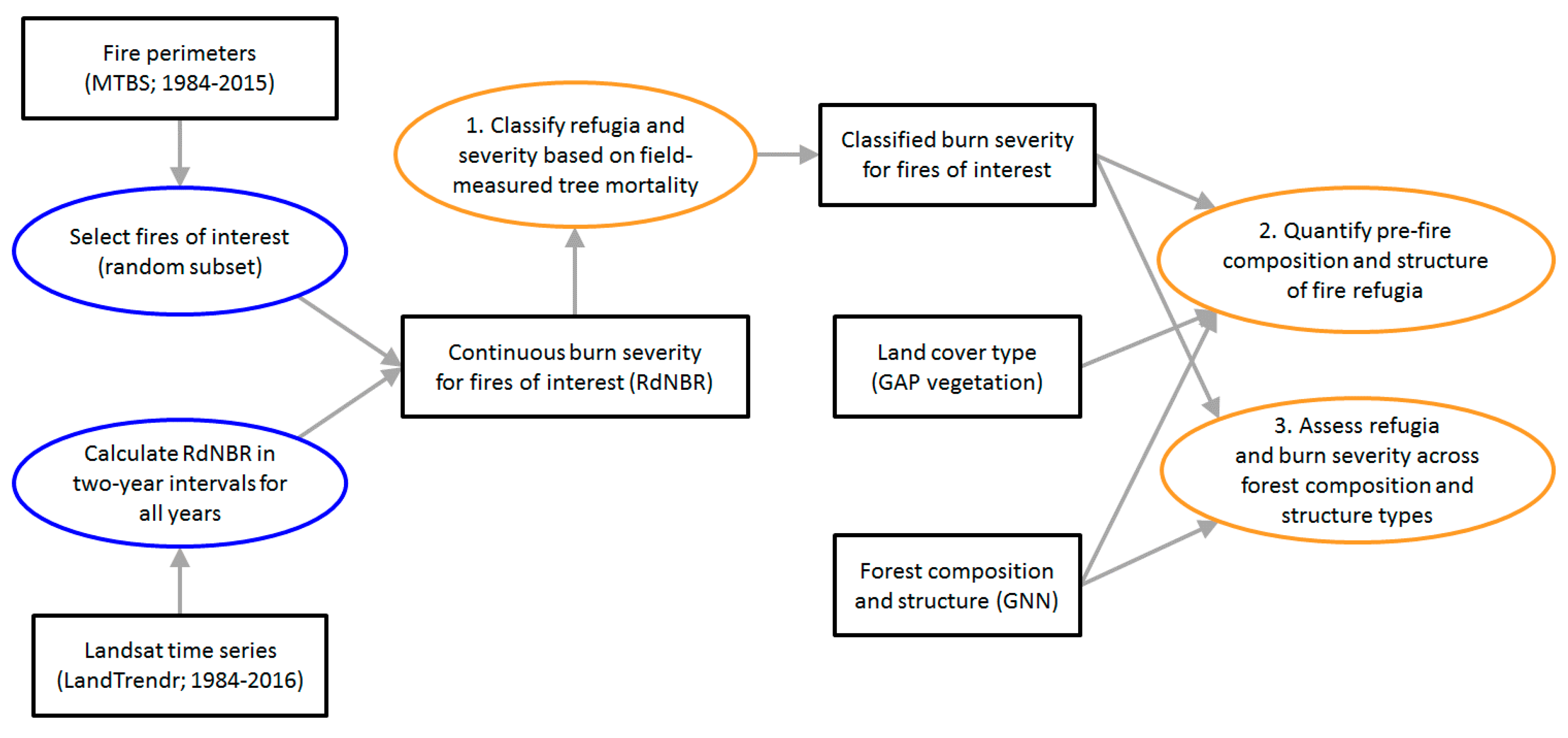

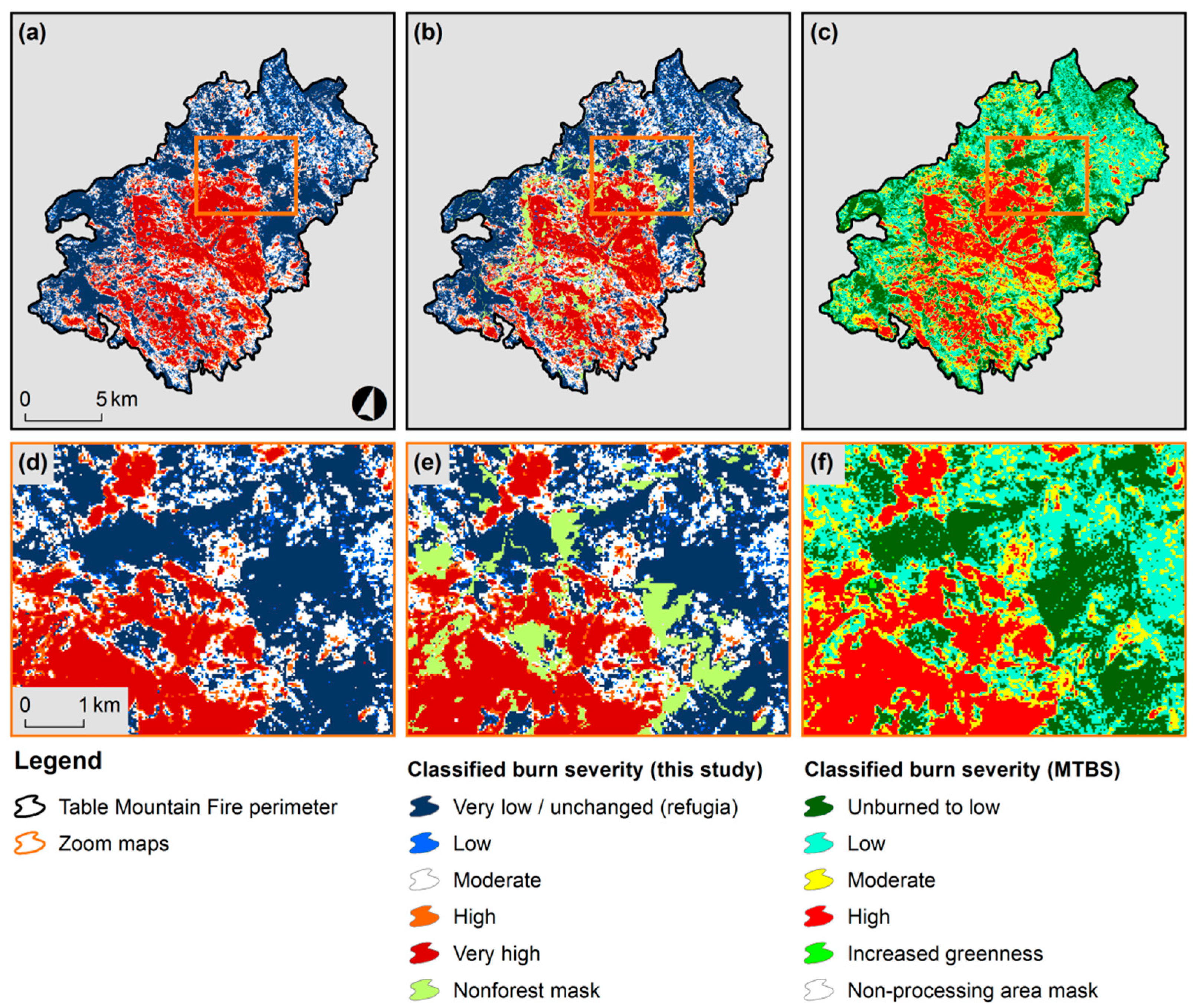
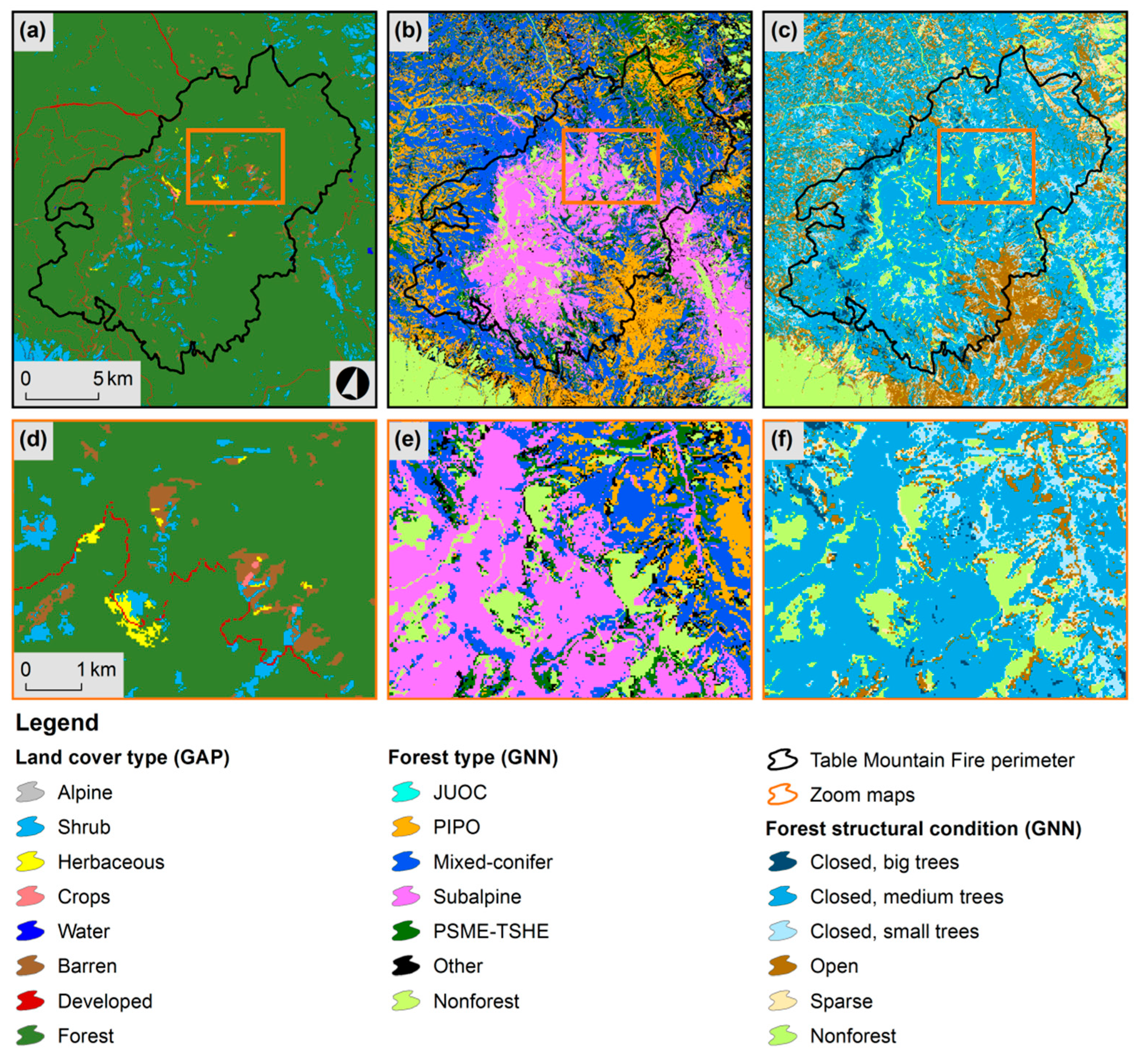

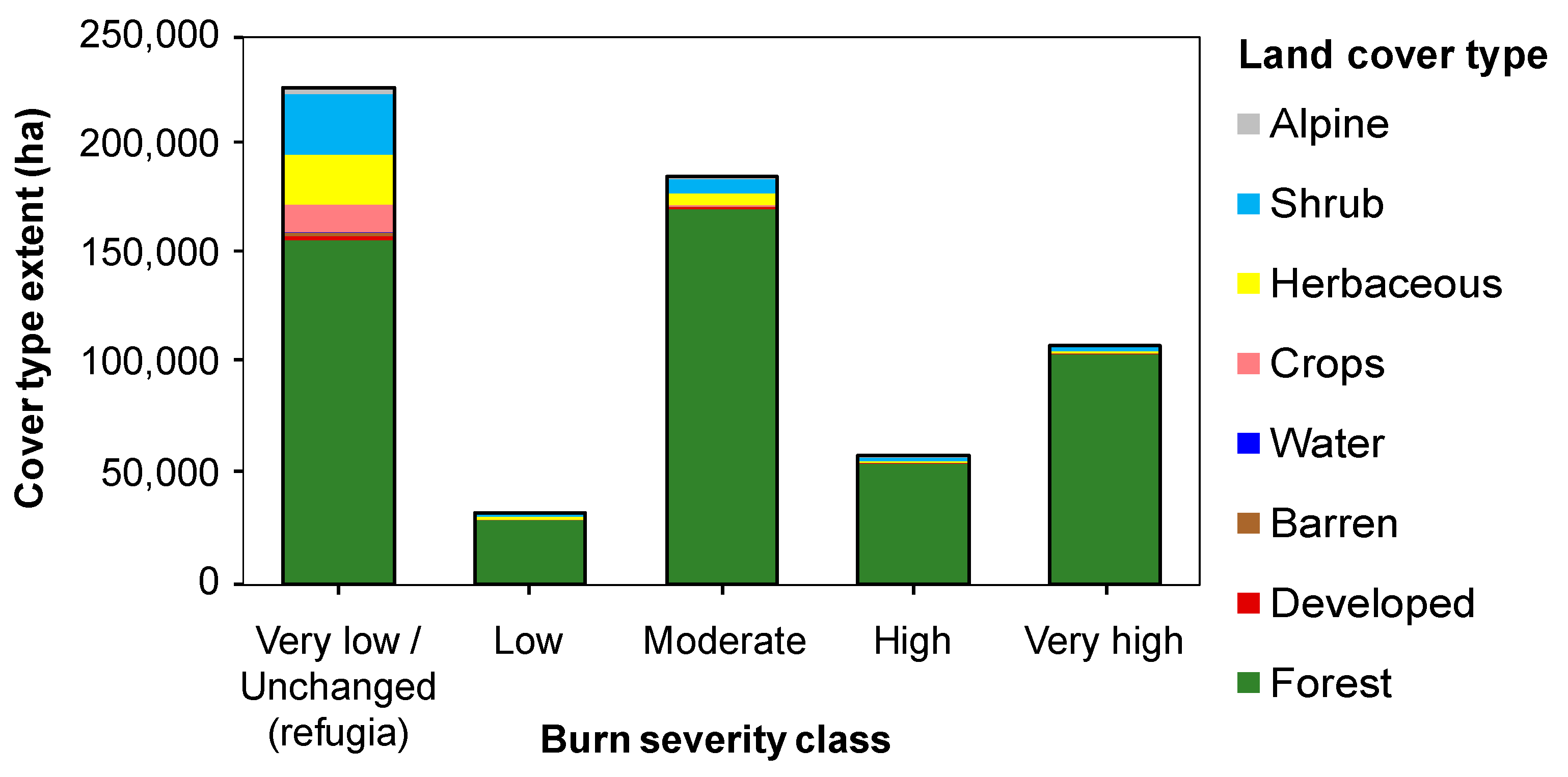

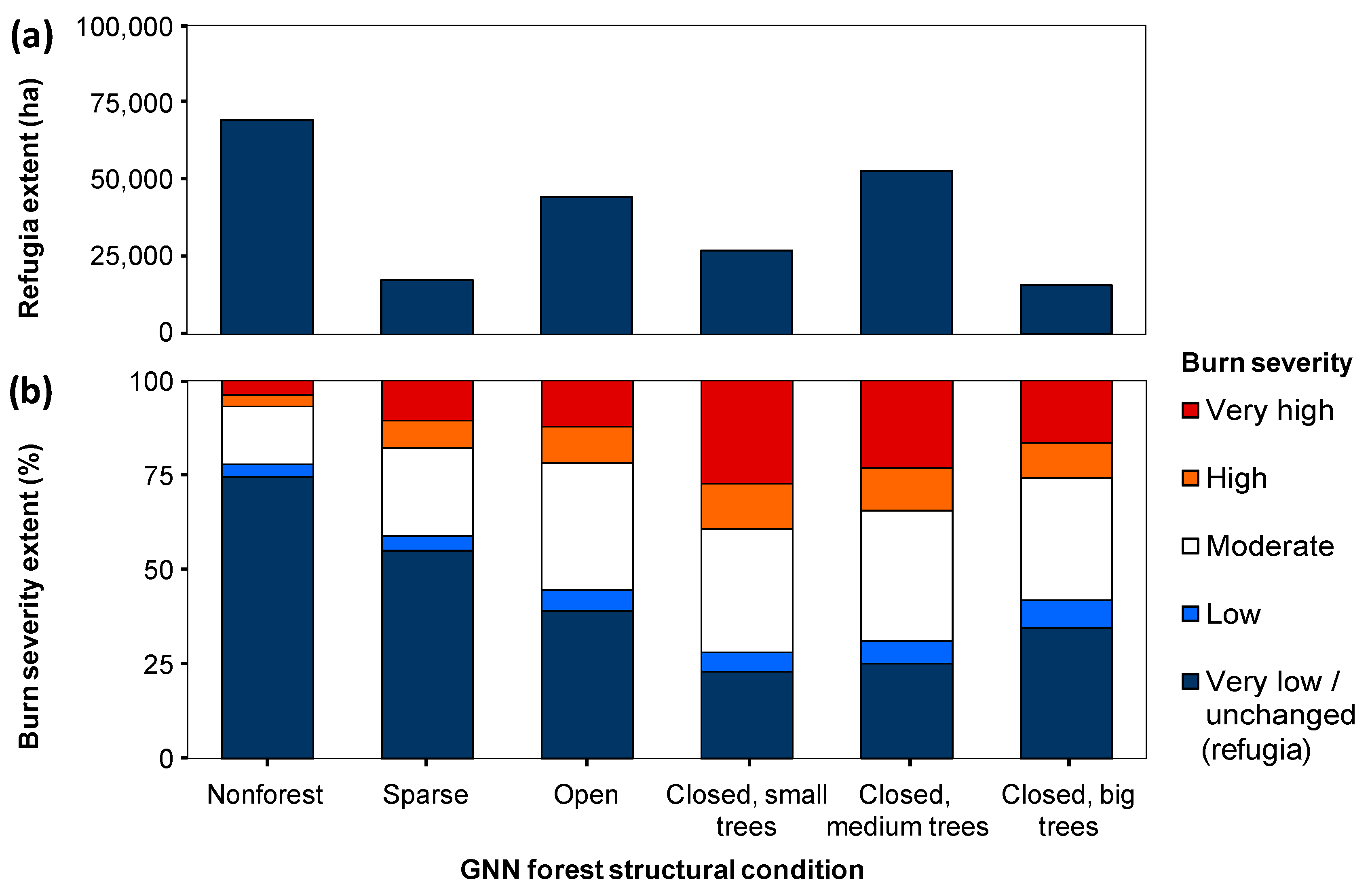
| Land Cover | Extent (Total ha) | Extent (% of Total) | Extent (Refugia ha) | Extent (% of Refugia) |
|---|---|---|---|---|
| Forest | 519,391 | 84.8 | 157,386 | 69.4 |
| Non-forest total | 93,238 | 15.2 | 69,413 | 30.6 |
| Non-forest vegetation | 87,426 | 14.3 | 65,689 | 29.0 |
| Alpine | 3905 | 0.6 | 2784 | 1.2 |
| Shrub | 38,951 | 6.4 | 27,498 | 12.1 |
| Herbaceous | 31,398 | 5.1 | 22,926 | 10.1 |
| Crops | 13,172 | 2.2 | 12,481 | 5.5 |
| Unvegetated | 5812 | 0.9 | 3724 | 1.6 |
| Water | 439 | 0.1 | 326 | 0.1 |
| Barren | 2279 | 0.4 | 1689 | 0.7 |
| Developed | 3094 | 0.5 | 1709 | 0.8 |
| Total | 612,629 | 100.0 | 226,798 | 100.0 |
| Variable | Units | Description |
|---|---|---|
| Forest type | categorical | Forest type, which describes dominant tree species (based on basal area) of current vegetation; simplified to general types (Table 3). |
| Structural condition | categorical | Structural condition based on size class and cover class (O’Neil et al. 2001) |
| Live tree basal area | m2 ha−1 | Basal area of live trees ≥2.5 cm DBH |
| Live tree density | stems ha−1 | Density of live trees ≥2.5 cm DBH |
| Tree age | years | Basal area weighted stand age based on field recorded or modeled ages of dominant and codominant trees |
| Quadratic mean diameter of dominant trees | cm | a Quadratic mean diameter (QMD) in centimeters of trees whose heights are in the top 25% of all tree heights on the plot |
| Diameter diversity index | H’ | b Diameter diversity index (DDI): a measure of stand structural complexity, based on tree densities in different diameter classes |
| Forest Type | Extent (Total ha) | Extent (% of Forested Total) | Extent (Refugia ha) | Extent (% of Refugia) |
|---|---|---|---|---|
| Other | 45,524 | 8.8 | 21,176 | 13.5 |
| PSME-TSHE | 91,234 | 17.6 | 25,980 | 16.5 |
| Subalpine | 133,311 | 25.7 | 26,207 | 16.7 |
| Mixed-conifer | 153,763 | 29.6 | 46,208 | 29.4 |
| PIPO | 79,818 | 15.4 | 26,786 | 17.0 |
| JUOC | 15,741 | 3.0 | 11,030 | 7.0 |
| Forested total | 519,391 | 100.0 | 157,387 | 100.0 |
| Burn Severity Class | RdNBR Value | Basal Area Mortality (%) | Extent (ha) | Extent (%) |
|---|---|---|---|---|
| Very low/unchanged (refugia) | ≤166.48 | 0–10 | 226,798 | 37 |
| Low | >166.48–235.20 | >10–25 | 32,645 | 5 |
| Moderate | >235.20–648.73 | >25–75 | 185,957 | 30 |
| High | >648.73–828.13 | >75–90 | 58,287 | 10 |
| Very high | >828.13 | 90–100 | 108,943 | 18 |
| Burn Severity | ||||||
|---|---|---|---|---|---|---|
| Variable (Units) | Statistic | Very Low/Unchanged (Refugia) | Low | Moderate | High | Very High |
| Live tree basal area | mean | 16.63 | 25.60 | 24.98 | 26.91 | 32.49 |
| (m2 ha−1) | SD | 19.17 | 19.00 | 18.05 | 17.98 | 18.52 |
| Live tree density | mean | 589.96 | 904.37 | 951.25 | 1094.74 | 1385.24 |
| (stems ha−1) | SD | 904.28 | 1014.74 | 1099.79 | 1230.42 | 1277.28 |
| Tree age | mean | 80.98 | 108.15 | 109.02 | 112.68 | 123.21 |
| (year) | SD | 72.29 | 63.84 | 60.37 | 58.17 | 56.44 |
| Quadratic mean diameter | mean | 12.51 | 17.22 | 16.99 | 16.87 | 16.52 |
| (QMD; cm) | SD | 11.11 | 9.83 | 9.33 | 8.92 | 8.43 |
| Diameter diversity index | mean | 2.40 | 3.56 | 3.49 | 3.59 | 3.80 |
| (DDI; H’) | SD | 2.29 | 2.08 | 1.95 | 1.87 | 1.82 |
© 2018 by the authors. Licensee MDPI, Basel, Switzerland. This article is an open access article distributed under the terms and conditions of the Creative Commons Attribution (CC BY) license (http://creativecommons.org/licenses/by/4.0/).
Share and Cite
Meigs, G.W.; Krawchuk, M.A. Composition and Structure of Forest Fire Refugia: What Are the Ecosystem Legacies across Burned Landscapes? Forests 2018, 9, 243. https://doi.org/10.3390/f9050243
Meigs GW, Krawchuk MA. Composition and Structure of Forest Fire Refugia: What Are the Ecosystem Legacies across Burned Landscapes? Forests. 2018; 9(5):243. https://doi.org/10.3390/f9050243
Chicago/Turabian StyleMeigs, Garrett W., and Meg A. Krawchuk. 2018. "Composition and Structure of Forest Fire Refugia: What Are the Ecosystem Legacies across Burned Landscapes?" Forests 9, no. 5: 243. https://doi.org/10.3390/f9050243
APA StyleMeigs, G. W., & Krawchuk, M. A. (2018). Composition and Structure of Forest Fire Refugia: What Are the Ecosystem Legacies across Burned Landscapes? Forests, 9(5), 243. https://doi.org/10.3390/f9050243





